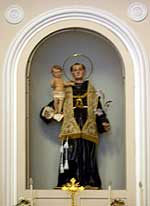Saint Anthony of Padova
 «The Church of saint Anthony of Padova rises not far from the railway station. «The Church of saint Anthony of Padova rises not far from the railway station.
Must have been erected during the first half of the 17th century, as there is no mention of it in the sacred visit of Torres in 1574 nor in the reveals of 1584, 1593, 1607, and not even in the registers of the Main Church.
The dreadful eruption of the 1651-1654, that caused so many damages to our town, burying churches, houses and fields, run over the little church on three sides: north, east and south. The lava reached the roof, adhering tightly to the easterly and southerly walls, filling even holes in the building, and, as for reverence or fear, when the impetuosity diminished, stopped in front of the door that was lightly scorched. In memory of the terrible happening, a wealthy citizen of Bronte, Francesco Spedalieri, paid for the building of a plaque on the external wall of the church with this inscription: D. 0. M.
Novi hanc Hyspaiarum
Serafi. Italiae Sideri,
Brontisqe e voracis
Etnae flammis liberatori
molem Francisc. Spi.ri
pp iis sumptibus costr.
curavit. 1654 The small church had five altars: on the right there were the altars of St Giovanni of God, and of St. Domenica; to the left, St Luigi and St Gaetano Tiene. |